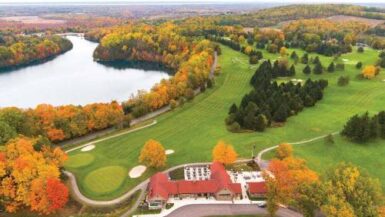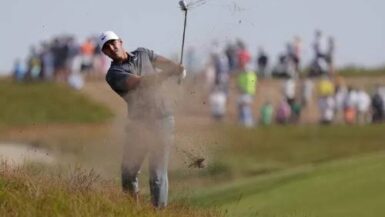Here’s a quick thumbnail sketch of the set-up at Bethpage Black for the U.S. Open:
First Hole – Par-4, 430 yards
High on a pulpit overlooking the first fairway, one can see a ribbon of fairway flanked by two sides of rough that are wider on either side than the intended target. The hole is a 90-degree dog-leg, the knee of which is guarded by a stand of tall trees. The first hole of the Green Course is further to the right. The green, which slopes back-to-front, is flanked by Rees Jones “inkblot” shaped bunkers which his typical rounded noses. This is a center-line hole all the way.
Second Hole – Par-4, 389 yards
Most pundits don’t like two, but I do. In fact, purely from a visceral standpoint, 2-6 are my favorite stretch on the golf course. A great shot shaping hole with horizontal movement, the fairway sits in a valley framed by trees and bends sharply to the left. The green is sharply elevated and guarded by deep bunkers and deep rough. Most players will take a fairway wood, hybrid, or iron off the tee.
Third Hole – Par-3, 232 yards (+32 from 2002)
232? I don’t think I’ve ever played this hole longer than 165! “This will be the long par-3,” said tournament set-up chair Mike Davis. The green, which is 45 yards deep and flat, is guarded by a bunker which cuts obliquely from back left to front right, much like a Redan set-up, but only superficially. Look for birdies here as the green has little if any interior contour.
Fourth Hole – Par-5, 515 yards
This is the iconic hole of the golf course. The mighty Glacier Bunker, one of Tillie’s typical “Great Hazards” he was so fond of building on par-5s at many of his courses, bisects the fairway and separates one tier from a second, elevated section of fairway. A deep bunker to the left off the tee must be avoided at all costs, as it sits well below fairway level. The second shot is played severely uphill to a tiny green guarded by another cavernous bunker. Miss left and you’re at the base of a 60 foot hill in murderous rough. You may even have a tree in the way. Even though it’s short on the card, the U.S.G.A. thinks fewer people will reach this green in two than the 525-yard par-4 7th hole, which is flat.
Fifth Hole – Par-4, 478 yards (+27 from 2002)
This is the other instantly recognizable hole on the golf course, and a textbook example of the heroic school of design. Players must challenge a deep bunker which cuts diagonally across the target line. There is plenty of room left, but that doesn’t matter because the further left you play, the higher and harder a hook you must hit to reach an elevated green guarded by two front bunkers. So the only realistic play is the center-line shot off the tee if you want a clear shot at the green from straight away.
Sixth Hole – Par-4, 408 yards
The players have options on this hole. In 2002, the hole played one way: straight off the tee, then turn left and play a mid-short iron to the green. This year, with the “left turn” portion of the fairway mown – not rough – players can blast a driver down the hill and have a pitch to a green encircled by deep sand. One day they may play the forward tees at about 340-350 so players can try to drive to the base of the hill.
Seventh Hole – Par-4, 525 yards (489 some days, +36 some days)
A par-5 for mere mortals, calling this hole a par-4 is simply pandering to machismo. As “the longest par-4 in U.S. Open history, it only affects egos, not aggregates. While the front bunker is not in play, the competitors may drive through the fairway into the bunker beyond the fairway. The hole has been doubled in width so players can comfortably hit driver.
Eighth Hole – Par-3, 230/135 yards
Featuring the only water hazard on the golf course, the front of the green has been moved closer to the green and the bank shaved. “We looked back at some old photographs of when Tillinghast first designed the course, and that’s the way the green used to be,” said Davis. “So for this go‑around we will have a couple hole locations right down at the front that very much bring the pond into play, and really, you would have to hit a horrendous shot in ’02 to hit it in the pond. It’s in play now.”
The hole also has two completely different tee boxes: one long and one short. The short box will be a wedge from 135 to a front pin near the pond. The green slopes severely back-to-front.
Ninth Hole – Par-4, 460 yards (+42 from 2002)
According to Davis, this whole saw the biggest changes from 2002. The easiest hole from the last Open may play as much as a quarter stroke harder this time. Hit a driver over what now is almost a cross bunker and have a wedge in, or play to the right of the bunker for a longer shot from an uneven stance. A bad drive means a blind hook to an elevated green guarded by two bunkers
Tenth Hole – Par-4, 508 yards (+12 yards)
Ten through thirteen are just long, long, long, long. This may be the stretch Dan Jenkins referred to when he observed that the course had a repetitive feel at times. After the debacle in 2002 when several players couldn’t carry the ball 280 to the fairway, the fairway has been extended back 35-40 yards towards the tee to eliminate that concern. Deep bunkers line both sides of the fairway.
Eleventh Hole – Par-4, 435 yards
Short on the card, but directly into the prevailing wind, this hole plays right back the other way from ten to a green that runs severely back-to-front. Gargantuan bunkers and towering fescue run along both side of the fairway.
Twelfth Hole – Par-4, 505 yards
The bunker on the left was reduced to allow aggressive players to hit the fairway instead of rough like in 2002. Along with 13, this dog-leg left is my least favorite hole on the course.
Thirteenth Hole – Par-5, 605/554 yards (+51 from 2002)
For openers, the fairway contours of this hole call for a fade off the tee, but the bunker on the left is on the outside if the recommended shot shape, not the inside. Next, the hole is so long that the only way to introduce strategy was to move the tee box up from 605 to 554.
Fourteenth Hole – Par-3, 158 yards
To add a hole location, the shortest hole on the course had the green extended in the front and left with a small false front. The green is now shaped like an alien face, with a wide brow in back, two depressions on the side for the eyes. Most pin placements will be in front, near the deep front bunker.
Fifteenth Hole – Par-4, 459 yards
Players cross the road back to the former meadow which holds holes 1 and 15-18 and arrive at another of the most recognizable holes on the course. Called the “corral hole” – presumably for the rail fence along the right side, the green sits 60 feet above fairway level. There are no fairway bunkers, so players will hit driver, but the green is guarded by two cavernous bunkers which are so deep, when you’re in them, you can’t be seen by your playing partners. The green is the most severe on the course. “The 15th green has a lot of slope on it, davis explained candidly. “In fact, I’ve woken up a couple of times in a cold sweat at night thinking about the 15th green, and I suspect it won’t be the last time I wake up in a cold sweat.” The players will be sweating too. I know for amateurs and public players, this tends to be the toughest four on the course.
Sixteenth Hole – Par-4, 490 yards, (+11 from 2002)
From the elevated tee box, players come back down the hill. Again, there are no fairway bunkers, but the right greenside bunker tilts the green right-to-left. Players should have little problem here.
Seventeenth Hole – Par-3, 207 yards
A figure-8 green laid on its side, five bunkers encircle the putting surface. It’s slightly uphill. The green has two pronounced tiers.
Eighteenth Hole – Par-4, 411 yards
Eighteen is not a great summation of all that came before. Shorter than almost every other par-4, and made shorter by the elevated tee, the fairway is wasp-waisted, pinched between two sets of Rees’s Rorshack-test shaped bunker complexes. It looks pretty on TV and has a natural amphitheatre for a setting, but it’s a bit anti-climactic for a closer. Then again, Cypress Point and Monterey Peninsula Country Club end on short fours too, so maybe someone will win by closing with a birdie.
Total: 7426 yards par-70



